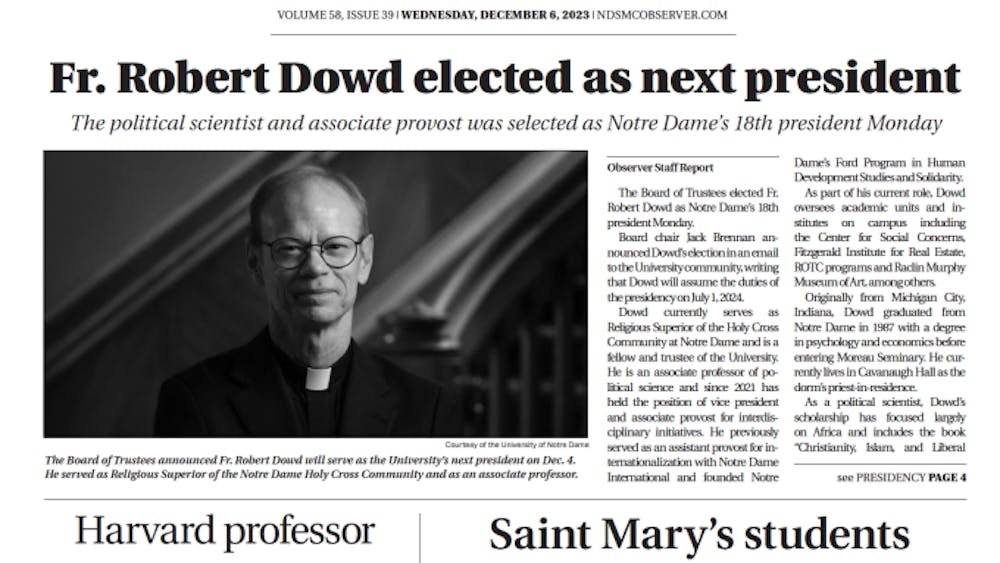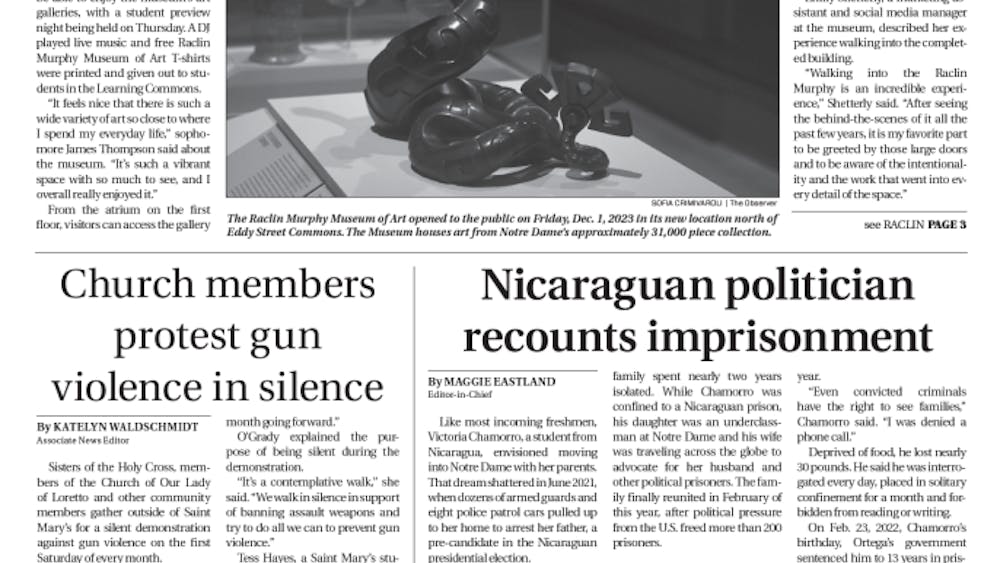Early in the morning, Oct. 12, 1492, a sailor aboard the Pinta glimpsed land in the distance - it was GuanahanÃ, a Bahamian island. The next day, Christopher Columbus' crew of 90 set foot on the its soil. Rechristening it San Salvador and claiming it for Spain, he concluded their voyage begun in Spain that August. The rest, as they say, is history.
This is how the pretty version goes. And, like Congress, unfortunately, Notre Dame seems to support it. In particular, this off-putting vignette adorns a hallway in the Main Building: prostrate Taino receiving Columbus. Is this right? Does this man deserve his glorified place under our beloved Dome, let alone his own holiday?
The "discovery" of the rest of the world is something worth celebrating, I suppose. This is something I have to take issue with for a couple reasons. For example: Can complex cultures of millions of people be "discovered?" Isn't that claim both racist and Eurocentric? And, that question aside, what about the archaeological evidence in Newfoundland of 11th-century Nordic settlements? Or British fisherman on the Canadian shores?
At least he proved the world was round, right? Nope. The Egyptian-Greek scientist Erastosthenes measured the circumference and diameter of the world in the third century B.C. Arab scientists had pioneered a whole discipline of geography and measurement, and in the 10th century A.D., Al Maqdisi described the earth with 360 degrees of longitude and 180 degrees of latitude. The Monastery of St. Catherine in the Sinai still has an icon - painted 500 years before Columbus - which shows Jesus ruling over a spherical earth.
But we stick with the romanticized, tenuous "official" line, however: we just pretend that Columbus was the first. Who wants to rock the boat? After all, without Columbus, surely Europe would never have found the other hemisphere. It would have escaped "civilization" at the hands of the Spaniards. The natives, needless to say, would have preferred this.
Nevertheless, conquerors care little for the preferences of the soon-to-be conquered. Upon meeting the peaceful, obliging Taino, Columbus wrote in his journal: "With 50 men we could subjugate them all and make them do whatever we want." Not exactly a model Christian.
It's estimated that within a few years of the Europeans' arrival, three-fourths of the native population perished. How?
First, there was murder. On Columbus second voyage, he demanded tribute from the Taino. All were expected to yield a certain quantity of gold per capita, or 25 pounds of cotton. Many who produced neither were brutally murdered, their hands were cut off and they were left to bleed to death. Kidnapping, torture and rape were the order of the day. In fact, many Taino were hunted for sport.
Second, there was disease. The Taino were prone to European diseases, especially smallpox. They spread like wildfire, ravaging the native population.
Third, there was slave export. Directly after his so-called discovery, he took natives as slaves, seizing 1,200 from the island of Hispaniola. They were paraded naked through the streets of Seville, then sold as slaves in 1495. Columbus blazed the trail for slavery in the Americas. It was after there weren't any natives left that the Europeans turned to Africa.
By 1555, from murder, disease and slave export, the Taino were all but eradicated.
Not surprisingly, many are reminded by this of the Holocaust. But unlike the Holocaust, where an estimated two-thirds of European Jews were killed, this genocide was total. And not only were the Taino entirely eradicated, but nearly all cultural traces were, as well.
What were Columbus' intentions? Each one is based on greed and glory. He sought a quicker route to Asia for spice merchants - trade was priority, then as now. He sought the one-tenth of the riches promised to him by Queen Isabella. He sought to forcibly convert them to Christianity.
We live in an era where imperialism and genocide still haunt the world. Columbus serves as such a perfect symbol of the two. And the legacy of Columbus is still felt today. In the richest country in the world, the poorest ethnic group is the Native Americans.
It's unclear why the University is so bent on exalting him, a man so inept that he was replaced and arrested in 1495. Does the administration plan on putting up some Himmler murals? Would President Malloy offer himself as the model, as President Walsh did for the Columbus muralist, Luigi Gregori?
Of course not. The apotheosis of Columbus should by now have become an embarrassing cultural relic. But somehow it has persisted. The University needs to show real moral clarity, to do its part in ending this curious secular mythology, this practice of honoring one of history's most dishonorable figures.
The prospect of moving Columbus Day to the first Tuesday after the first Monday in November - to honor democracy instead of empire - and renaming it Election Day is pretty remote. But starting small, acting locally, isn't. Doing away with the offensive Columbus murals would be a fine start.
BJ Strew is a junior English major. His column appears every other Monday. Contact him at wstrew@nd.edu.The views expressed in this column are those of the author and not necessarily those of The Observer.









